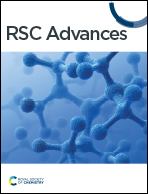Mechanism of cationic ring-opening polymerisation of ε-caprolactone using metallocene/borate catalytic systems: a DFT and NCI study on chain initiation, propagation and termination†
Abstract
We present a comprehensive DFT investigation on the cationic ring-opening polymerisation (CROP) of ε-caprolactone (CL) using zirconocene/borate catalyst systems. All possible pathways of the interaction between cationic species [Cp2ZrMe+] and counteranions, [A−] = [MeB(C6F5)3]− and [B(C6F5)4]−, were examined during chain initiation, propagation, and termination steps. The calculations reveal an active chain-end mechanism with O-alkyl bond cleavage of the polymerisation. The catalytic performance of the two counteranions is found to be identical, and they influence the initial process through stabilisation of the cationic species via non-covalent interactions (NCI), with the [MeB(C6F5)3]− anion stabilising the catalyst–monomer complex more effectively than the [B(C6F5)4]− anion by 24.3 kJ mol−1. The first two propagations are likely the rate-determining step, with calculated free-energy barriers of 61.4–71.2 and 73.9–80.6 kJ mol−1 with and without the anions (A−), respectively. The presence of the counteranion significantly affects the third propagation rate, lowering the barriers up to 20 kJ mol−1. Comparison of the first termination and the third propagation shows that they are not competitive, with the termination being less facile. We also studied the initiation and propagation steps for the hafnocene catalyst and found that the Hf catalyst slightly favours the CL CROP in comparison to the Zr catalyst. Analysis of solvent and dispersion interaction demonstrates that both factors play an important role in the process. NCI analysis reveals weak (van der Waals) interactions at the contacts between the cationic species and the counteranions during the reaction course. Overall, our results offer insights into the structures and interactions involved in the polymerisation.



 Please wait while we load your content...
Please wait while we load your content...